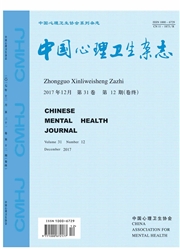

 中文摘要:
中文摘要:
目的:探讨学龄儿童日常皮质醇节律与其学校适应行为之间的关系。方法:方便选取北京市一所普通小学四年级学生,经家长和儿童同意,66名儿童自愿参加了本研究。在学校通过同伴提名法和教师评价儿童行为问卷法,收集儿童的学习问题、攻击破坏性、害羞敏感性和同伴接受性数据;儿童在学校期间共收集6次唾液样本,每次大约间隔45min。采用酶联免疫吸附法分析唾液样本中的皮质醇水平,以获得儿童日常皮质醇节律数据。结果:女生同伴接受性得分高于男生[(0.31±O.81)vs(-0.51±0.94),P〈0.001],而学习问题和攻击破坏行为得分低于男生[(-0.13±0.95)vs(0.42±1.08),(-0.28±0.71)vs(0.46±1.10),均P〈0.05];皮质醇的变化峰值与儿童的害羞敏感性呈正相关(r=0.28,P〈0.05),与同伴接受性呈负相关(r=-0.30,P〈0.05);在学校期间皮质醇的变化速率与攻击破坏行为、害羞敏感呈正相关(r=0.26,0.34;P〈0.05或0.01),与同伴接受性呈负相关(r=0.33,P〈0.01)。结论:学校日常皮质醇的变化幅度和变化速率可作为反映儿童学校适应行为的指标。
 英文摘要:
英文摘要:
Objective: To investigate the relation between children's diurnal cortisol rhythm in school and their school adjustment. Methods: Sixty-six grade 4 students from Beijing participated in the study. Children's aggression-disruption, shyness-sensitivity were rated by peers through peer nomination at school Teachers completed a questionnaire to rate children's learning problems and aggression-disruption. Children's saliva cortisol samples were collected 6 times a day during school time, with an interval of roughly 45 minutes. ELISA was used to assay saliva cortisol. Results: Girls got higher score in peer acceptance [ (0. 31 ±0. 81 ) vs. ( -0. 51±0. 94 ), P 〈0. 001 ], lower score in learning problem and aggression-disruption [ ( - 0. 13 ± 0. 95 ) vs. { 0. 42 ± 1.08 ), ( - 0. 28 ± 0. 71 ) vs. (0. 46 ± 1.10), Ps 〈0. 05] than boys. The peak value of diurnal cortisol in school was positively correlated to children' s shyness-sensitivity ( r = 0. 28, P 〈 0. 05 ), and negatively correlated to peer acceptance { r = -0. 30,P 〈0. 05 ) . The slope of cortisol change in school was positively correlated to children' s aggression-disruption (r=0.26, P〈0.05), and shyness-sensitivity {r=0.34, P〈0.01), and negatively correlated to their peer acceptance ( r =0. 33, P 〈0. 01 ) . Conclusion: The change of cortisol fluctuation in school may be a good indicator for school adjustment of children.
 同期刊论文项目
同期刊论文项目
 同项目期刊论文
同项目期刊论文
 期刊信息
期刊信息
